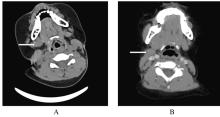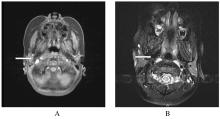Journal of Jilin University(Medicine Edition) ›› 2022, Vol. 48 ›› Issue (1): 228-233.doi: 10.13481/j.1671-587X.20220129
• Clinical medicine • Previous Articles Next Articles
Kawasaki disease with inflammatory changes in parapharyngeal space:A case report and literature review
Song SU,Hongbo WANG,Yucong MA,Xin FANG,Junrong LIU,Hongmei QIAO( )
)
- Department of Pediatric Respiratory Medicince,First Hospital,Jilin University,Changchun 130021,China
-
Received:2021-07-24Online:2022-01-28Published:2022-01-17 -
Contact:Hongmei QIAO E-mail:qiaohm@jlu.edu.cn
CLC Number:
- R725.4
Cite this article
Song SU,Hongbo WANG,Yucong MA,Xin FANG,Junrong LIU,Hongmei QIAO. Kawasaki disease with inflammatory changes in parapharyngeal space:A case report and literature review[J].Journal of Jilin University(Medicine Edition), 2022, 48(1): 228-233.
share this article
| 1 | 杜曾庆, 刘晓梅, 杨 震. 川崎病并发无菌性脑膜炎3例[J]. 中国实用儿科杂志, 2007, 22(5): 394. |
| 2 | LI Y C, YANG Q R, YU X H, et al. A case of Kawasaki disease presenting with parotitis: a case report and literature review[J]. Medicine (Baltimore), 2019, 98(22): e15817. |
| 3 | 毛雨鸽, 孙 燕, 张清友. 以咽旁间隙炎症为主要表现的不完全川崎病1例报告并文献复习[J]. 临床儿科杂志, 2020, 38(12): 912-914. |
| 4 | 董春娟, 徐勇胜. 以咽后壁炎症为主要表现的不完全川崎病一例[J]. 中华耳鼻咽喉头颈外科杂志, 2016, 51(11): 859-861. |
| 5 | MCCRINDLE B W, ROWLEY A H, NEWBURGER J W,et al. Diagnosis, treatment, and long-term management of Kawasaki disease: a scientific statement for health professionals from the American heart association[J]. Circulation, 2017, 135(17): e927-e999. |
| 6 | YOSKOVITCH A, TEWFIK T L, DUFFY C M,et al. Head and neck manifestations of Kawasaki disease[J]. Int J Pediatr Otorhinolaryngol, 2000, 52(2): 123-129. |
| 7 | ISIDORI C, SEBASTIANI L, ESPOSITO S. A case of incomplete and atypical Kawasaki disease presenting with retropharyngeal involvement[J]. Int J Environ Res Public Health, 2019, 16(18): E3262. |
| 8 | ALDEMIR-KOCABAŞ B, KCAL M M, RAMOĞLU M G, et al. Recurrent Kawasaki disease in a child with retropharyngeal involvement: a case report and literature review[J]. Medicine (Baltimore), 2014, 93(29): e139. |
| 9 | HUNG M C, WU K G, HWANG B, et al. Kawasaki disease resembling a retropharyngeal abscess: case report and literature review[J]. Int J Cardiol, 2007, 115(2): e94-e96. |
| 10 | HOMICZ M R, CARVALHO D, KEARNS D B,et al. An atypical presentation of Kawasaki disease resembling a retropharyngeal abscess[J]. Int J Pediatr Otorhinolaryngol, 2000, 54(1): 45-49. |
| 11 | ROH K, LEE S W, YOO J. CT analysis of retropharyngeal abnormality in Kawasaki disease[J]. Korean J Radiol, 2011, 12(6): 700-707. |
| 12 | TERAI M, HONDA T, YASUKAWA K, et al. Prognostic impact of vascular leakage in acute Kawasaki disease[J]. Circulation, 2003, 108(3): 325-330. |
| 13 | LANGLEY E W, KIRSE D K, BARNES C E, et al. Retropharyngeal edema: an unusual manifestation of Kawasaki disease[J]. J Emerg Med, 2010, 39(2): 181-185. |
| 14 | FANG L C, SHYUR S D, PENG C C, et al. Unusual manifestations of Kawasaki disease with retropharyngeal edema and shock syndrome in a Taiwanese child[J]. Wei Mian Yu Gan Ran Za Zhi, 2014, 47(2): 152-157. |
| 15 | KAO H T, HUANG Y C, LIN T Y. Kawasaki disease presenting as cervical lymphadenitis or deep neck infection[J].Otolaryngol Head Neck Surg, 2001, 124(4): 468-470. |
| 16 | TONA R, SHINOHARA S, FUJIWARA K, et al. Risk factors for retropharyngeal cellulitis in Kawasaki disease[J]. Auris Nasus Larynx, 2014, 41(5): 455-458. |
| 17 | AU D C Y, CHUNG FONG N, YWAH KWAN. Kawasaki disease with retropharyngeal edema: case series from a single center experience[J]. Chin Med J (Engl), 2019, 132(14): 1753-1754. |
| 18 | NOZAKI T, MORITA Y, HASEGAWA D, et al. Cervical ultrasound and computed tomography of Kawasaki disease: Comparison with lymphadenitis[J]. Pediatr Int, 2016, 58(11): 1146-1152. |
| 19 | KATO H, KANEMATSU M, KATO Z, et al. Computed tomographic findings of Kawasaki disease with cervical lymphadenopathy[J]. J Comput Assist Tomogr, 2012, 36(1): 138-142. |
| 20 | LIM S, LEE N Y, HAN S B, et al. Deep neck inflammation: probable Kawasaki disease in Korean children[J]. Clin Exp Otorhinolaryngol, 2020, 13(1): 77-82. |
| 21 | GANESH R, SRIVIDHYA V S, VASANTHI T,et al. Kawasaki disease mimicking retropharyngeal abscess[J]. Yonsei Med J, 2010, 51(5): 784-786. |
| 22 | MACHAIRA M, TSOLIA M, CONSTANTOPOULOS I, et al. Incomplete Kawasaki disease with intermittent fever and retropharyngeal inflammation[J]. Pediatr Infect Dis J, 2012, 31(4): 417-418. |
| 23 | NOMURA O, HASHIMOTO N, ISHIGURO A,et al. Comparison of patients with Kawasaki disease with retropharyngeal edema and patients with retropharyngeal abscess[J]. Eur J Pediatr, 2014, 173(3): 381-386. |
| 24 | VURAL C, GUNGOR A, COMERCI S. Accuracy of computerized tomography in deep neck infections in the pediatric population[J].Am J Otolaryngol,2003,24(3): 143-148. |
| 25 | CHIAPPINI E, CAMAIONI A, BENAZZO M, et al. Development of an algorithm for the management of cervical lymphadenopathy in children: consensus of the Italian society of preventive and social pediatrics, jointly with the Italian society of pediatric infectious diseases and the Italian society of pediatric otorhinolaryngology[J]. Expert Rev Anti Infect Ther, 2015, 13(12): 1557-1567. |
| [1] | Xin SHEN,Yang LIU,Hongyu CHEN,Jie ZHANG,Qingli CHENG,Guang YANG. Regulatory effect of high glucose on polarization of RAW264.7 macrophages via miR-125b in mice [J]. Journal of Jilin University(Medicine Edition), 2022, 48(4): 847-857. |
| [2] | Na HAN,Fanping LIU,Yanqing TIAN,Zhiqing ZHENG,Weiming LANG,Qian WANG,Yatao LIU,Jianguang ZHU. Regulatory effect of miRNA-27a on immune function in experimental pulmonary tuberculosis rats and its mechanism [J]. Journal of Jilin University(Medicine Edition), 2022, 48(1): 104-110. |
| [3] | Mimi REN,Menghan GAO,Jing WANG,Jiamei LAI,Jinyu YU,Hang YUAN. Protective effect of 12/15-lipoxygenase gene knockout on kidney tissue of obesity-related glomerulopathy model mice and its mechanism [J]. Journal of Jilin University(Medicine Edition), 2021, 47(6): 1337-1346. |
| [4] | Liyan ZHU,Yaoming WANG,Zheng QIN,Huanhuan ZHAO,Zengying WANG,Xiuhong YANG. Improvement effect of angiotensin(1-7) on kidney injury induced by limb ischemia-reperfusion in mice and its mechanism [J]. Journal of Jilin University(Medicine Edition), 2021, 47(4): 834-841. |
| [5] | Xue LUAN, Guanghai YAN, Haibo LI, Bo ZHANG, Wei ZHANG, Yuanyuan HUANG. Effect of salidroside on airway inflammation in mice with asthma and its mechanism [J]. Journal of Jilin University(Medicine Edition), 2021, 47(3): 537-544. |
| [6] | Lijun YAN,Shengquan TONG,Jing LIU,Dongmei GAO,Nanfang CHEN,Jie HU. Therapeutic effect of total glucosides of paeony in model rats with rheumatoid arthritis by mediating TLR4/NF-κB signaling pathway and its mechanisim [J]. Journal of Jilin University(Medicine Edition), 2021, 47(2): 390-396. |
| [7] | QIAO Liangwei, QU Qingshan, LI Ming. Effect of LncRNA-ATB on acute rejection of kidney transplanted rats by regulating miR-200c expression [J]. Journal of Jilin University(Medicine Edition), 2020, 46(05): 955-962. |
| [8] | ZHAO Liping, HUANG Shubing, ZHANG Boping, ZHOU Zhilan, JIA Xuebing, SUN Mengfei, QIAO Chenmeng, CHEN Xue, SHEN Yanqin, CUI Chun. Inhibitory effect of Lactobacillus rhamnosus on intestinal inflammation after spinal cord injury in zebrafishes and its mechanism [J]. Journal of Jilin University(Medicine Edition), 2020, 46(04): 680-686. |
| [9] | WANG Yazhou, HE Peng, WANG Danhong. Effects of montelukast on proliferation and apoptosis of airway smooth muscle cells in asthmatic rats by inhibiting TLR4/NF-κB signaling pathway [J]. Journal of Jilin University(Medicine Edition), 2020, 46(02): 274-279. |
| [10] | WANG Tianyue, ZHOU Qianlan, SHANG Yunxiao. Effect of epigallocatechin-3-gallate on airway inflammation and Treg/Th17 immune balance of mice with obese asthma [J]. Journal of Jilin University(Medicine Edition), 2019, 45(03): 491-497. |
| [11] | WANG Xuemin, DENG Shurong, PENG Lingling, PAN Maohua, PAN Yuzheng. Dynamic changes of pulmonary morphology and mast cell activity in rats after tracheotomy and intubation and their significances [J]. Journal of Jilin University(Medicine Edition), 2019, 45(02): 262-267. |
| [12] | YUAN Zhongzheng, LIU Yin, SHEN Yuqin, LIN Chongtao. Effect of periodontitis patient's own tissue nucleic acid on expression of NLRP3 mRNA in murine macrophages and its significance [J]. Journal of Jilin University(Medicine Edition), 2019, 45(01): 23-27. |
| [13] | RAN Qin, ZHANG Lei, ZHANG Yun, QIU Yuhuan, YUAN Xiefang, WANG Xiaoyun, TANG Hongmei, WANG Xing, LI Guoping. Inhibitory effect of resveratrol on pulmonary inflammation in mice with neutrophilic asthma and its mechanism [J]. Journal of Jilin University(Medicine Edition), 2018, 44(05): 897-902. |
| [14] | ZHANG Sheng, PIAO Jinhua, LIANG Xue. Analysis on clinical characteristics of Kawasaki disease with joint involvement in children [J]. Journal of Jilin University Medicine Edition, 2018, 44(04): 820-824. |
| [15] | HUO Lianguang, YAN Qingtao, YAN Jingyue, LI Na, SU Han, ZHANG Meijia, MAO Shumei, GAO Zhiqin, QU Meihua. Improvement effect of duodenal-jejunal bypass on inflammatory status of biliopancreatic limb of ZDF rats and its mechanism [J]. Journal of Jilin University Medicine Edition, 2017, 43(06): 1155-1160. |







